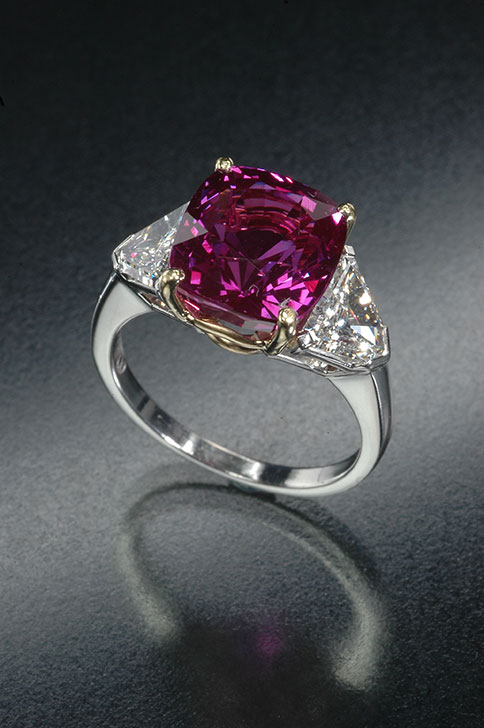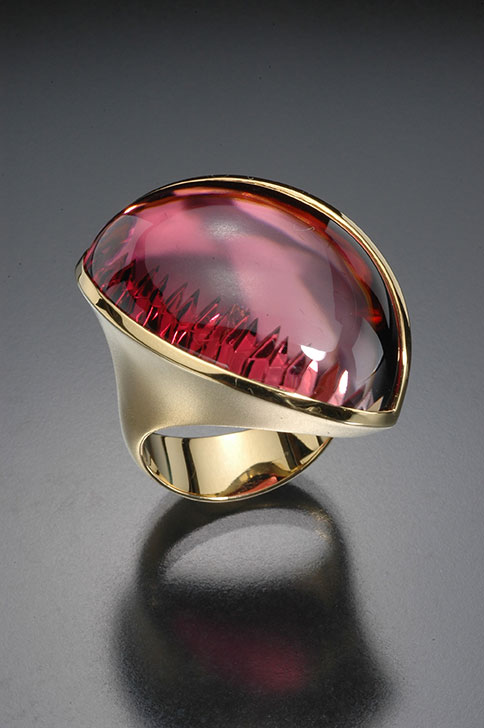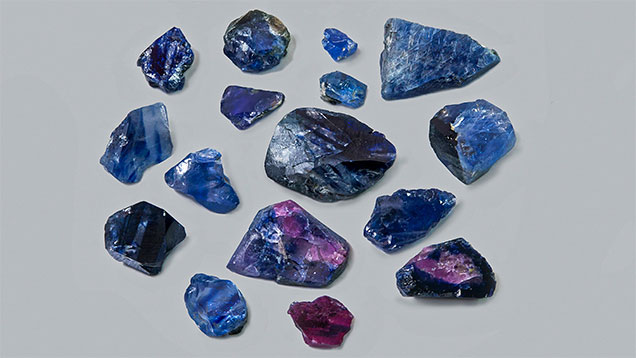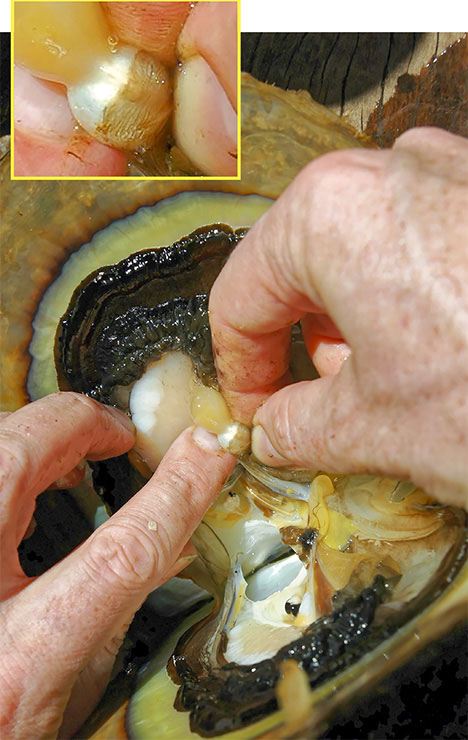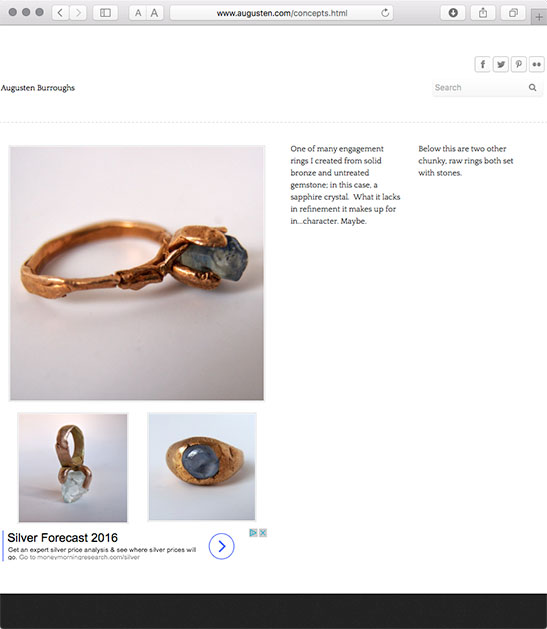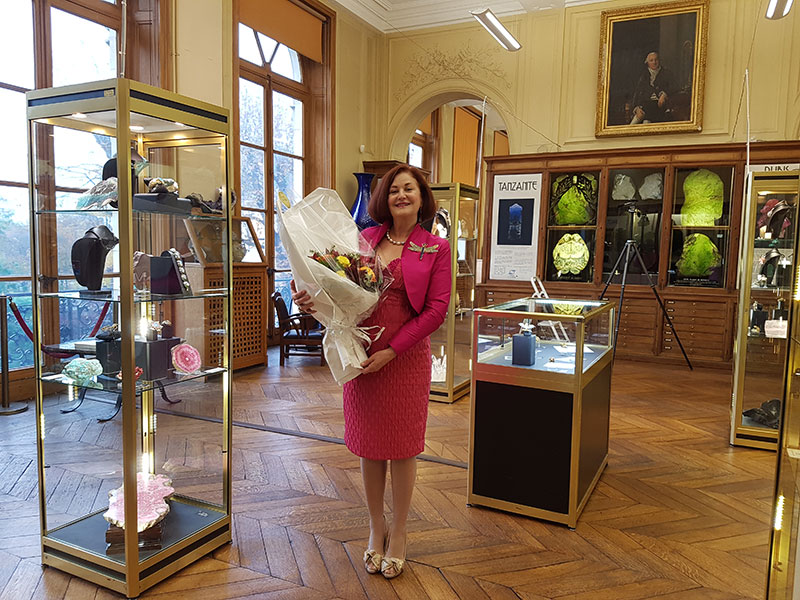December 2016
December 2016
Getting to the root of the problem. It seems that root vegetables have a habit of turning up wedding bands for gardeners who were unlucky enough to lose them. One such soul is an 82-year-old man in Bad Münstereifel, Germany who lost his ring three years ago while tilling the soil. Earlier this fall he checked on his carrots only to find that one of the taproots had drilled through the lost finger-ring's hoop, above. Unfortunately its 3.5-carat Burma ruby was not recovered. (Kidding…) The octogenarian's wife, who had since passed on, was certain the ring would be found again. (See original WDR story in German and Bored Panda in English.)
Five years ago a Swedish farmer had a similar experience, as reported by BBC (English) and Dagens Nyheter (Swedish, Dec. 30, 2011 and Feb. 3, 2012). In 1995, Lena Påhlsson removed her wedding band to do some Christmas baking with her daughters. She likely allowed the ring, set with seven small diamonds, to fall into vegetable peelings that were composted or fed to sheep whose manure fertilized her garden. Thinking the ring, which she'd designed herself, still might be in the house, the family even removed the kitchen floor's tiling years later. In 2011, sixteen years after the ring went missing and while preparing raised garden boxes for winter, she pulled out a carrot that was too small and noticed something glistening around it. Påhlsson's tale took on a life of its own, being one of the most widely read stories in Britain, and featuring her on an American talkshow. Belgian jewelry designer Hilde de Decker had been inspired by earlier stories of such recovery and decided to purposely grow vegetables with her jewels, as shown on a page of her online portfolio from 1999, below. (Thanks to Pala's Mia Dixon for Swedish translation.)
Table of Contents
Shows and Events
Pala International News
Gems and Gemology News
Industry News
Books
Pala Presents
- Simple Rules for the Discrimination of Gems
by T. S. G Kirkpatrick
Recycle Bin
- Illuminations: Earth to Jewel
Crevoshay in Paris, through Feb. 1, 2017 - GIA Receives Gift of Ornamental Minerals
David Hughes, Editor
Shows and Events
Tucson Time: Jan. 31 – Feb. 12, 2017
After the holidays, we're looking forward to the world's greatest gem and mineral show in January and February. One-stop general information about individual shows, shuttle routes, and more can be obtained from the Tucson EZ-Guide.
Pala International will be represented in Tucson as follows. We look forward to seeing our many friends there. Visit the Pala International Show Schedule for future events.
AGTA GemFair Tucson
January 31 – February 5, 2017
Tucson Convention Center
Pala International Booth: 1016
Website
Pala joins nearly 100 exhibitors for this trade-only annual extravaganza.
The event website features an interactive floorplan allowing you to see who is exhibiting by area of the convention center.
Free seminars by notables in the world of gemstones and pearls are listed. Also listed are several special events and exhibits.
Read about the AGTA GemFair app here.
The American Gem Trade Association (AGTA) is an association of United States and Canadian trade professionals dedicated to promoting the long term stability and integrity of the natural colored gemstone and Cultured Pearl industries. The Association pursues its goals through the combined use of educational programs, publicity, industry events, government and industry relations, and printed materials for both the trade and consumer.
16th Annual Westward Look Mineral Show
February 3–6, 2017
Westward Look Resort
Pala International:
Suite 224, Building 20, Upper Level
Website (newly redesigned)
Pala International and three dozen other world-class mineral dealers shack up at the Sonoran Desert resort.
See Pala International's page on the Westward Look Show site. See also this dealer list.
The annual Saturday Collector Day this time will be devoted to the collection of the Rice Northwest Museum of Rocks and Minerals. (See the December 2014 writeup on the museum in our sibling newsletter, Pala Mineralis.) The annual Sunday Evening Program is yet to be announced.
Christophe Gobin shares some of his great mineral specimens at last year's Westward Look Show.
63rd Annual Tucson Gem & Mineral Show
February 9–12, 2017
Tucson Convention Center
Pala International:
Booths 828–929A
Website
TGMS is the largest gem and mineral show in the country. This year's theme is "Mineral Treasures of the Midwest."
Lectures are held each day of the Show in the Crystal Ballroom and Turquoise Ballroom at the SMG-Tucson Convention Center.
The Arthur Roe Memorial Micromount Symposium is held on Friday, February 10, also in the Turquoise Ballroom.
The show's Saturday Night Program will include a silent auction benefitting Mindat.org and the Geo-literary Society, remarks by the TGMS President and Show Chair, an awards presentation, buffet dinner and live auction.
For everyone who came to the 2016 Tucson Gem and Mineral Show® and would like to revisit some of the spectacular exhibits, and for those of you who weren't lucky enough to attend: For your viewing pleasure, the Tucson Gem and Mineral Society and BlueCap Productions present this video, comprised of six of our "Spotlight Cases" that were in the 2016 Tucson Gem and Mineral Show®, "Shades of Blue – Minerals of the World."
The Cora N. Miller Collection
by Richard W. Wise
Cora Nunnally Miller with one of her beloved Whippets, descendants of greyhounds.
Editor's Remark: Last month, I noted the October 13 opening of the David Friend Hall in the Peabody Museum of Natural History at Yale University. In particular, I highlighted some selections from the Cora N. Miller Collection, but implied that jewels from this collection were on loan. I was corrected by Richard Wise, author of the newly released Secrets of the Gem Trade, Second Edition, which contains many images from the Cora N. Miller Collection. Richard sourced the gems in this collection and facilitated its acquisition by Yale University. Intrigued, I asked him if he'd provide background on the collection.
Gathered over a period of fifteen years, The Cora N. Miller Collection includes a number of exceptional gems including rubies, emerald, diamond, several black opals, sapphires and tourmaline. Mrs. Miller was only interested in the best of the best and over the course of years developed a very discriminating eye. She was not interested in glitz; she insisted on wearable sizes, normally five to ten carats, though her definition of "wearable" did expand somewhat over the years.
Borealis, a rare Lightning Ridge black opal. This is a red multicolor opal of the rare harlequin pattern (N1-N2). "One of the finest harlequins ever found," says Richard Wise in describing this gem from the Cora N. Miller Collection. (Photo: Jeff Scovil, courtesy R. W. Wise, Goldsmiths)
Mrs. Miller enjoyed and wore her gems and had them set, mostly in rings, fabricated in our workshop. Going about her business in the rural Berkshires of Massachusetts she was often complimented and queried about her gems, which she wore daily. Wishing to avoid undue attention, she enjoyed describing an eleven-carat Fancy Vivid Yellow diamond as a citrine, a six-carat Winza ruby or a five-carat natural Burma ruby as a garnet. Most people having never seen gems of such exceptional quality readily believed her, not realizing that she wore a fortune sparkling on her finger.
Peacock Pendant. 18k and 22k opal pendant in the Art Nouveau style. Click to view detail. (Photo: Jeff Scovil, courtesy R. W. Wise, Goldsmiths)
Mrs. Miller enjoyed participating in the design of pieces into which her exquisite gemstones were set. Her Peacock Pendant is a case in point. She loved Art Nouveau design and we spent many an interesting hour working with Michael Corneau, our chief designer, myself and my wife Rebekah, paging through books on Art Nouveau before settling on elements of the design. The finished brooch includes, besides two exceptional 9-to-11-carat black Lightning Ridge opals, Burma rubies, Ceylon sapphires and Nigerian spessartite garnets along with Mississippi river pearls. The construction took over one hundred fifty hours.
An exceptional 12-carat balas ruby from the old mines at Kuh-i-Lal. The best red spinels from this source show little orange secondary hue and were misidentified as rubies for many centuries. From the Cora N. Miller Collection. (Photo: Jeff Scovil, courtesy R. W. Wise, Goldsmiths)
About ten years into the process, Mrs. Miller expressed concern about the fate of the collection once she passed on. She was anxious that the collection be kept together, be displayed and used for some educational purpose. We also planned to include it in the second edition of my book, so Jeff Scovil was commissioned to photograph the entire collection.
Golconda diamond, 9.07 ct, from the Cora N. Miller Collection. (Photo: Jeff Scovil, courtesy R. W. Wise, Goldsmiths)
After some discussion with other institutions, we invited Jay Ague, Museum Director, and Stefan Nicolescu, Curator, from the Yale Peabody Museum of Natural History to Lenox to view the collection. They were impressed and expressed a strong desire to acquire it, assuring Mrs. Miller that the collection would be on continuous display. After examining a 9.07-carat D-Flawless Golconda diamond from the collection, Jay Ague, who is also head of the Geology Department at Yale, surprised us by noting the gem's ultra transparency. The guy's knowledge obviously went way beyond rock strata.
Up to that point the Yale Peabody collection was strong in mineral specimens, but had few exceptional finished gemstones. The Cora N. Miller Collection would become the foundation upon which the Yale gem collection would be built.
Purple sapphire, 7.51 ct, from the Cora N. Miller Collection. (Photo: Jeff Scovil, courtesy R. W. Wise, Goldsmiths)
Yale Peabody is very much a teaching facility. On the day my wife and I visited, we videotaped a member of the museum staff who was lecturing, in the Mineral Hall, to a rapt class of grade school children gathered around the mineral exhibit, sitting on tiny stools. After viewing this video, Mrs. Miller decided that the collection should go to Yale Peabody.
Gems for the collection came from many sources. Some were purchased in New York, others in Bangkok, Hong Kong and Tucson. Cora always insisted on making the final decision. So, I would put together a selection. This was not easy and sometimes meant that I would have literally millions of dollars in gems in my Lenox gallery on a given day. Luckily, over the years, I developed solid relationships with some of the world's leading gem dealers. This was very important. Although it is always a good idea to keep your clients close, reputation is all and it is almost more important to keep your dealers closer. In this small-rarified world of museum-quality gems, you must keep your word and pay your bills.
Burma ruby, 5.5 ct, from the Cora N. Miller Collection. (Photo: Jeff Scovil, courtesy R. W. Wise, Goldsmiths)
As I said, Mrs. Miller liked to make the final choice from among several gems, but she often took our recommendation. She particularly solicited my wife Rebekah's opinion. In one case, she was focused on obtaining a Burma ruby while I strongly advocated a six-carat Winza gem. I remember we had four top gem rubies sitting in a tray in front of us. She took the Burma, a wonderful five-carat vivid blood-red gem. The next morning she called me at home. She had decided she wanted the Winza too.
The Pumpkin or The One That Got Away
After reading my newly published book Secrets Of The Gem Trade in 2004, Mrs. Miller became interested in fancy color diamonds. Not just any colored diamond, she decided to acquire an orange diamond. She had read about the famous Pumpkin, a 4.54-carat Fancy Vivid Orange purchased by Harry Winston at auction for $1.3 million in 1998. She made an appointment, traveled to New York and called at the famous 5th Avenue jeweler. That evening she called me from her hotel suite. Apparently an overanxious female sales associate at Winston made some erroneous statements about orange diamonds. When she returned to her suite, she looked up the appropriate chapter in my book and found the errors. She called me to confirm.
Not The Pumpkin, but this spessartite garnet, from the Cora N. Miller Collection, exhibits its own pure orange color. (Photo: Jeff Scovil, courtesy R. W. Wise, Goldsmiths)
The following day she returned to Winston's. This time Ronald Winston met with her personally. She examined the Pumpkin Diamond, which Winston was offering at $3.0 million. During the course of their discussion, Winston offered to clean a five-carat padparadscha sapphire ring purchased from me. He took the opportunity to carefully examine the gem. "Oh," he told her, "this is a beautiful stone. We find it difficult to obtain stones of this quality today," or words to that effect. Mrs. Miller left the store and never went back.
About a year later, I received a call from a prominent New York dealer. He knew that I had put out a call for a Fancy Vivid Orange diamond. "The Pumpkin is on offer,” he told me. Why? Ronald Winston had taken on a partner to buy out his brother and the new management decided that The Pumpkin had been in inventory too long. It was, to use the accounting term, a non-performing asset. The diamond was being offered at a substantial discount from the former asking price. I immediately called Mrs. Miller. She had just acquired an eight-carat Fancy Vivid Yellow emerald cut diamond reputed to be the finest, purest yellow in existence and decided to pass. The Pumpkin sold later that week to a Chinese buyer for $2.9 million. She later bitterly regretted that decision. Today, the diamond is worth somewhere north of $15 million. She later gave the Vivid Yellow emerald cut to a female relative.
Tourmaline. A beautiful ring featuring a stone faceted in its distinctive style by the famous Atelier Tom Munsteiner of Idar-Oberstein. From the Cora N. Miller Collection. (Photo: Jeff Scovil, courtesy R. W. Wise, Goldsmiths)
For more on Cora N. Miller the woman, see this obituary from the Atlanta Journal-Constitution.
Colorful Quartet
The Natural History Museum of Los Angeles Gem and Mineral Vault presents four colored diamonds beginning tomorrow, December 16. On display in "Diamonds: Rare Brilliance" are the Juliet Pink, 30.03 ct, pictured here; the Rainbow Necklace, featuring rare blue-gray diamonds; the Argyle Violet, the largest such diamond to be produced by its namesake Australian mine; and the Victorian Orchid.
The exhibit continues through March 19, 2017.
Pala International News
Pala's Featured Stones
Mozambique Tourmaline Trio
For this month's feature we have neon tourmalines from Mozambique. We couldn't settle for just one so we chose our favorite three. They are all stunning, fully saturated and ready for a lucky piece of jewelry. The overall color is well balanced in each of these gemstones.
We decided to leave the stones untreated due to their magnificent natural color. It is very rare to see natural purples of this quality. Stones often are heated to improve color, but in our opinion, it was unwarranted for these rare pieces.
Interested? Contact us!
Gems and Gemology News
Research Roundup
Below are several items emanating from three gem labs in the U.S. and Asia.
AIGS: Gem Dictionary in English and Chinese
From a-axis to Zwartlaagte, the Asian Institute of Gemological Sciences in Bangkok now offers everyone a free Gem Dictionary mobile app in English and Chinese. Like any dictionary, you can search on a given term. The app also lets you browse by initial letter and by your own viewing history, and flag favorite words. AIGS news and information also are pushed to the app.
The dictionary is based on a Japanese-language book, Dictionary of Gemstones & Jewelry, by the late Akira Chikayama (1921–2007), issued in 1995, revised in 2004. The first English edition, translated and edited by Stephen H. Gill, was released in 2013, and is still available. A preview of the front matter and "A" entries is offered. The Chinese-language content was developed by the Beijing Institute of Gemology under the auspices of the National Gemological Training Center in cooperation with AIGS.
A sample entry. The bracketed abbreviations likely will be familiar to students of gemology, but if not, these are available on page 10 of the preview mentioned above. Some entries have irregular letter spacing, as indicated by the boxed example. But, hey, it's free and a welcome addition to the gem and mineral enthusiast's mobile toolbox.
GIA: Colored Stones and Pearls
GIA has produced several recent studies that will be of interest to aficionados of gemstones and pearls.
"Purple Pyrope-Almandine Garnet From Mozambique" studies lively purple garnets from East Africa. Gemological field trips likely won't take place soon, however; the locality is controlled by the armed rebel group Mozambican National Resistance.
"Blue Sapphire Reportedly from Badakhshan, Afghanistan" looks at gemstones from another war-torn country, in a province known for millennia for its production of lapis lazuli. Researchers are challenged, however, since these sapphires' inclusions display the hallmarks of sapphire from another famous region—Kashmir.
These blue and purplish sapphires are reportedly from a new deposit near Khash in Badakhshan Province, Afghanistan. The largest stone weighs 19.6 ct and measures 19.2 × 13.9 mm. (Photo: Lhapsin Nillapat, © GIA)
"'Punsiri'-type FTIR Spectral Features in Natural Yellow Sapphires" shows that a yellow sapphire which initially appeared to have had a "Punsiri" high-temperature heat treatment—normally found in blue sapphire—actually can be found in natural specimens.
"Bead-Cultured and Non-Bead-Cultured Pearls from Lombok, Indonesia" takes the reader and viewer into all aspects of a cultured pearl farm in south-central Indonesia—from the crucial hatchery operation to the obtaining of samples, allowing GIA researchers to observe pearl positioning firsthand.
Removal of a bead-cultured pearl (sample 100307378805) from its host mollusk. The pearl sac is clearly visible as a light brown area around the pearl (inset). (Photo: Jeffery Bergman, © GIA)
"Tourmaline Termination" examines a mineral dear to the heart of Pala International: a blue-cap tourmaline termination that was salvaged by Tucson gem artist Falk Burger. The piece is not from San Diego County, however, but rather from Madagascar, and it allowed GIA's John Koivula to delve into its micro-world.
Highlighted by blue and pink color accents, trigonal growth features are clearly visible on the surface of this 42.78-ct polished tourmaline termination. (Photo: Kevin Schumacher, © GIA)
Lotus Gemology: Exploring the Micro-terrain
Like GIA's John Koivula, the staff members of Lotus Gemology in Bangkok have a love of gemstones' inner world—to the tune of posting more than six hundred images of photomicrography in their Hyperion inclusion search engine/gallery, as we've mentioned before. In conjunction with that gallery are two new features: "Hyperion Siamese Twins – Gem Inclusion Pairs" comparing before-and-after images, differences in lighting, etc., and the extensive bibliography "Hyperion Sources – Literature on Inclusions in Gemstones" that lists monographs, photomicrography techniques, historical articles and more.
Imaginary Landscape. Parallel dislocation needles were seen in a single twin plane just above the fissure. (Photo: E. Billie Hughes/Lotus Gemology)
"Padparadscha or Pretender – An Unusual Pink-Orange Sapphire" also moves the viewer through the micro-terrain of eye-catching inclusions, as illustrated above. The stone in question was thought to be a 14-carat padparadscha sapphire from Sri Lanka, submitted to test for enhancements. The results could have fooled the less-than-thorough gemologist.
Six Myths About the Koh-i-Noor
In May, we looked at some of the history and contention of ownership of the Koh-i-Noor, one of the world's most famous diamonds. Gemstone history buffs will enjoy taking a pop quiz of sorts posted last Friday by BBC News, which examines "Six myths about a priceless diamond" and the reality behind them. Good luck…
For the story behind this lithograph (Koh-i-Noor shown in two views at top center), see our "Koh-i-Noor: She Wants Me, She Wants Me Not" from last May.
Industry News
Augusten Burroughs, Author, Collector, Designer…
Augustan Burroughs is an author of many memoirs, including Running with Scissors, which was made into a film by the same name starring Annette Bening and Alec Baldwin. Somewhat of a renaissance man, he has a background in advertising, has worked in radio and appeared on television, has an honorary doctorate, directed a music video, and is working on screenplays. He's also a jewelry collector and self-taught gemologist who has designed some funky engagement rings, below, that remind us of Hilde de Decker's vegetable jewels, above.
Burroughs's affection for antique jewels was profiled earlier this month on the New York Times website and appeared in last Sunday's print edition. Read "Augusten Burroughs's Love Affair With Jewelry" and see a few examples of his favorite things, including some gorgeous jadeite. Other views of his collection are found on his website.
Burma Bits
U.S., Europe Shun Emporium in Droves
The first gems emporium held in Burma following the lifting of sanctions was supposed to attract new buyers from the United States and Europe. It didn't happen, as reported by Myanmar Times on December 2, days after the November 20–29 sale. Had the foreigners shown up, they might have been in for disappointment. "Emporium jade lots leave traders unimpressed" was the Myanmar Times headline midway through the sale. The article quotes dealers who complained about the poor quality and high price tags of jade lots. The Irrawaddy reported that only two U.S. traders attended the sale, and the entire number of attendees dropped by 200; about 1,800 traders were registered from China, Hong Kong, Taiwan and Thailand.
The total brought in from the emporium was only €327 million ($445 million). This compares with €600 million in July and €900 million last December. Jade export statistics for April to November 11 this year were disappointing as well: $377 million versus $544 million the year before, according to Eleven Media Group.
Burmese Amber Yields Dino Tail
A Chinese paleontologist made a "once in a lifetime" discovery of a dinosaur tail preserved in amber at a market in Myanmar. Read the report in Current Biology.
Bite-Sized Bits
- Myanmar Times: Mogok on $160 a day, according to "Unearthing hidden gems"
- Myanmar Times: Mogok's Bernard Village (Bernardmyo) could become tourist destination
Books
Ex Libris GIA – Behind the Scenes
A year ago this month we looked at the books being digitized by GIA's Liddicoat Library, which is culling from some of the rarest treasures in its Cartier Rare Book Repository and Archives. This year we point to a glance behind the scenes of that effort.
GIA research librarians Augustus Pritchett, left, and Sarah Ostrye have digitized more than 200 rare books from the Institute's collection in the last two years. (Photo: Emily Lane, © GIA)
"Rare Books Project Puts Gem and Jewelry History Within Reach" gives readers an idea of the breadth of GIA's physical holdings as well as the institutional vision to make worldwide access to rare material a reality. This did not happen overnight. For one thing, there's not a single digitization technology; the options had to be considered for a project that will involve thousands of titles from the library's 64,000-volume collection. The past two years have brought us access to more than 200 titles. And that's a rare treat.
Pala Presents
Simple Rules for the Discrimination of Gems
by T. S. G. Kirkpatrick
With Pala Presents, we offer selections from the library of Pala International’s Bill Larson, who shares some of the wealth of information in the realm of minerals and mineralogy.
For whatever reason, the cover's stamping of Simple Rules does not match its title page.
T. S. G. Kirkpatrick was Chairman of The Orita Gold Mines, Limited; Director of The Golden Gate Alluvial Syndicate, Limited; Director of The Gravel Gold Mines of Colombia, Limited; and recipient of a Master of Arts degree from Oxford University.
In the course of his mining pursuits, Kirkpatrick hit a snag—of the environmental protection sort. According to a volume of reports from officials concerned with the "Mines; Rivers Pollution Prevention Act," Kirkpatrick, along with others, was prosecuted and convicted for infringing five sections of the Metalliferous Mines Regulation Act in 1883. Apparently he had been co-owner of the Nant-y-cria lead mine (which has a Welsh ring to it).
By the time T. S. G. Kirkpatrick wrote the twenty-page Simple Rules for the Discrimination of Gems (1895), he had written the equally brief (at forty-seven pages) Hydraulic Gold Miners' Manual (1890) from which Simple Rules is excerpted.
The shorter book is not illustrated and mainly identifies gemstones via specific gravity and hardness, but it does describe some other methods. And, of course, there is Tall Gipsy Girl Flew Up Fells Queer To Go Die!
Recycle Bin
Illuminations: Earth to Jewel
Crevoshay in Paris, through Feb. 1, 2017
In September we notified readers about Paula Crevoshay's Illuminations: Earth to Jewel. Earlier this month we treated readers of our sibling newsletter to photos from the exhibition opening.
We've just received word from Eloïse Gaillou, Associate Curator of the exhibition venue, Musée de minéralogie MINES ParisTech, that there's a possibility the show will be extended beyond February 1. And Eloïse will be lecturing on the exhibit on Thursday, January 19, 2017. Registration for the lecture is mandatory; details here.
Paula Crevoshay stands amidst her own creations as well as those of Mother Earth in the exhibition hall prior to the opening of Illuminations: Earth to Jewel. Over her shoulder is a painting of Balthazar Georges Sage, first director of the School of Mines, 1783–1790. (Photo: Farida Maouche, MINES ParisTech) See more photos here »
GIA Receives Gift of Ornamental Minerals
Visitors to, and residents of, Southern California have a lot of museums to browse. Lovers of minerals and gemstones—and art—can whet their visual appetite by visiting just one institution: the GIA Museum in Carlsbad.
Variations on a Theme: 25 Years of Design from the AJDC celebrates the silver anniversary of the American Jewelry Design Council with 150+ examples of work created for the nonprofit's annual themes. Perry Davis's gem and mineral sculptures have intriguing titles like Ice Tree and Tao of Rutile, and the carvings themselves show off the materials' compelling qualities. The myth of the Dragon King's Daughter is told in painstaking detail through a (pre-ban) elephant ivory carving featuring an orb composed of thirty-eight (!) concentric spheres. And contemporary art aficionados will enjoy Visions in Crystal, created by third-generation Idar-Oberstein gem cutter Tom Munsteiner, whose six-foot-tall sculpture is composed of 264 rock crystal quartz tiles that each shimmer, and together create a larger pattern.
The Museum's newest objects are ornamental minerals from a sixty-three-piece donation by the family of Joel and Barbara Hauser, fifty of which are currently displayed. Read about the donation here »
Azurite, Bisbee, Arizona. (Photo: Orasa Weldon, © GIA)
— End December Newsletter • Published 12/15/16 —
We welcome your feedback.












